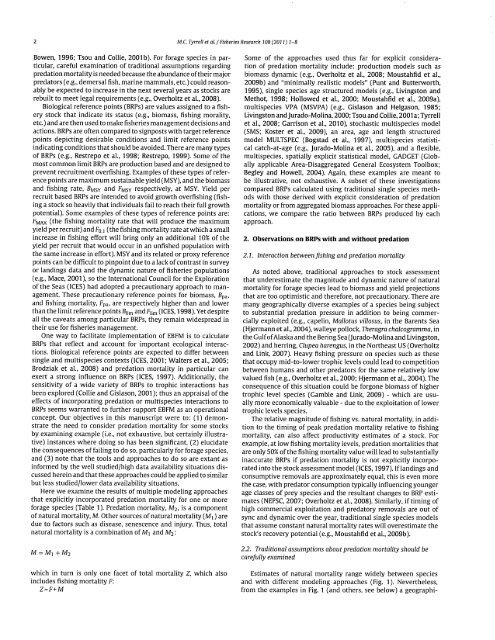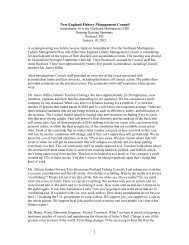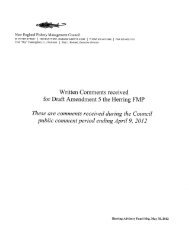Correspondence/Amendment 5 Comments - New England Fishery ...
Correspondence/Amendment 5 Comments - New England Fishery ...
Correspondence/Amendment 5 Comments - New England Fishery ...
Create successful ePaper yourself
Turn your PDF publications into a flip-book with our unique Google optimized e-Paper software.
Bowen, 1996; Tsou and Collie,2001b). For forage species in particular,<br />
careful examination of traditional assumptions regarding<br />
predation mortality is needed because the abundance of their major<br />
predators (e.g., demersal fish, marine mammals, etc.) could reasonably<br />
be expected to increase in the next several years as stocks are<br />
rebuilt to meet legal requirements (e.g., Overholtz et al.,2008).<br />
Biological reference points (BRPs) are values assigned to a fishery<br />
stock that indicate its status (e.g., biomass, fishing morality,<br />
etc.) and are then used to make fisheries management decisions and<br />
actions. BRPs are often compared to signposts with target reference<br />
points depicting desirable conditions and limit reference points<br />
indicating conditions that should be avoided. There are many types<br />
of BRPs (e.g., Restrepo et al., 1998; Restrepo, 1999). Some of the<br />
most common limit BRPs are production based and are designed to<br />
prevent recruitment overfishing. Examples of these types of reference<br />
points are maximum sustainable yield (MSY), and the biomass<br />
and fishing rate, B¡45y and F¡¡5y respectively, at MSY. Yield per<br />
recruit based BRPS are intended to avoid growth overfishing (fishing<br />
a stock so heavily that individuals fail to reach their full growth<br />
potential). Some examples of these tlpes of reference points are:<br />
F¡a¡¡ (the fishing mortality rate that will produce the maximum<br />
yield per recruit) and Fe.1 (the fishing mortality rate at which a small<br />
increase in fishing effort will bring only an additional 10% of the<br />
yield per recruit that would occur in an unfished population with<br />
the same increase in effort). MSY and its related or proxy reference<br />
points can be difficult to pinpoint due to a lack of contrast in survey<br />
or landings data and the dynamic nature offisheries populations<br />
(e.g., Mace, 2001), so the lnternational Council for the Exploration<br />
ofthe Seas (ICES) had adopted a precautionary approach to management.<br />
These precautionary reference points for biomass, Bpa,<br />
and fishing mortality, Fpa, êr€ respectively higher than and lower<br />
than the limit reference points B¡. and F1¡* (ICES, 1998). Yet despite<br />
all the caveats among particular BRPs, they remain widespread in<br />
their use for fisheries management.<br />
One way to facilitate implementation of EBFM is to calculate<br />
BRPs that reflect and account for important ecological interactions.<br />
Biological reference points are expected to differ between<br />
single and multispecies contexts (ICES, 2001; Walters et al., 2005;<br />
Brodziak et al., 2008) and predation mortality in particular can<br />
exert a strong influence on BRPs (ICES, 1997). Additionally, the<br />
sensitivit¡r of a wide varietSr of BRPs to trophic interactions has<br />
been explored (Collie and Gislason,200l); thus an appraisal ofthe<br />
effects of incorporating predation or multispecies interactions to<br />
BRPs seems warranted to further support EBFM as an operational<br />
concept' Our objectives in this manuscript were to: (1) demonstrate<br />
the need to consider predation mortality for some stocks<br />
by examining example (i.e., not exhaustive, but certainly illustrative)<br />
instances where doing so has been significant, (2) elucidate<br />
the consequences offailing to do so, particularly for forage species,<br />
and (3) note that the tools and approaches to do so are extant as<br />
informed by the well studied/high data availability situations discussed<br />
herein and that these approaches could be applied to similar<br />
but less studied/lower data availability situations.<br />
Here we examine the results of multiple modeling approaches<br />
that explicitly incorporated predation mortality for one or more<br />
forage species (Table 1). Predation mortality, M2, is a component<br />
of natural mortality, M. Other sources of natural mortality (M1) are<br />
due to factors such as disease, senescence and injury. Thus, total<br />
natural mortality is a combination of M1 and M2:<br />
M:Mt*Mz<br />
M.C.TyreI et al. / Fisheries Research 108 (2011) 1-8<br />
Some of the approaches used thus far for explicit consideration<br />
of predation mortality include: production models such as<br />
biomass dynamic (e.g., Overholtz et al., 2008; Moustahfid et al.,<br />
2009b) and "minimally realistic models" (Punt and Butterworth,<br />
1995), single species age structured models (e.g., Livingston and<br />
Methot, 1998; Hollowed et al., 2000; Moustahñd et al., 2009a),<br />
multispecies VPA (MSVPA) (e.g., Gislason and Helgason, 1985;<br />
Livingston andJurado-Molina, 2000; Tsou and Collie, 2001 a; Tyrrell<br />
et al., 2008; Garrison et al., 2010), stochastic multispecies model<br />
(SMS; Koster et al., 2009), an area, age and length structured<br />
model MULTSPEC (Bogstad et al., 1997), multispecies statistical<br />
catch-at-age (e.g., Jurado-Molina et al., 2005), and a flexible,<br />
multispecies, spatially explicit statistical model, GADGET (Globally<br />
applicable Area-Disaggregated General Ecosystem Toolbox;<br />
Begley and Howell, 2004). Again, these examples are meant to<br />
be illustrative, not exhaustive. A subset of these investigations<br />
compared BRPs calculated using traditional single species methods<br />
with those derived with explicit consideration of predation<br />
mortality or from aggregated biomass approaches. For these appli<br />
cations, we compare the ratio between BRPs produced by each<br />
approach.<br />
2. Observations on BRPs with and without predation<br />
2.1. Interaction between fishing and predation mortality<br />
As noted above, traditional approaches to stock assessment<br />
that underestimate the magnitude and dynamic nature of natural<br />
mortality for forage species lead to biomass and yield projections<br />
that are too optimistic and therefore, not precautionary. There are<br />
many geographically diverse examples of a species being subject<br />
to substantial predation pressure in addition to being commercially<br />
exploited (e.g., capelin, Mallons uillosus, in the Barents Sea<br />
( Hjermann et al., 20(X), walleye pollock, The r agra chalc o gr ammq in<br />
the Gulf ofAlaska and the BeringSea (Jurado-Molina and livingston,<br />
2002) and herring, Clupea harengus, in the Northeast US (Overholtz<br />
and Link, 2007). Heavy fishing pressure on species such as these<br />
that occupy mid-to-lower trophic levels could lead to competition<br />
between humans and other predators for the same relatively low<br />
valued fish (e.g., Overholtz et a1.,2000; Hjermann et al., 2004). The<br />
consequence of this situation could be forgone biomass of higher<br />
trophic level species (Gamble and Link, 2009) - which are usually<br />
more economically valuable - due to the exploitation of lower<br />
trophic levels species.<br />
The relative magnitude of fishing vs. natural mortality, in addition<br />
to the timing of peak predation mortalitSr relative to fishing<br />
mortality, can also affect productivity estimates of a stock. For<br />
example, at low fishing mortality levels, predation mortalities that<br />
are only 50% of the fishing mortality value will lead to substantially<br />
inaccurate BRPs if predation mortality is not explicitly incorporated<br />
into the stock assessment model (ICES, 1997). Iflandings and<br />
consumptive removals are approximately equal, this is even more<br />
the case, with predator consumption typically influencing younger<br />
age classes of prey species and the resultant changes to BRP estimates<br />
(NEFSC,2007; Overholtz et a1.,2008). Similarly, if timing of<br />
high commercial exploitation and predatory removals are out of<br />
sync and dynamic over the year, traditional single species models<br />
that assume constant natural mortality rates will overestimate the<br />
stock's recovery potential (e.g., Moustahfid et al., 2009b).<br />
2.2, Traditional assumptions about predation mortality should be<br />
carefully examined<br />
which in turn is only one facet of total mortality Z which also Estimates of natural mortality range widely between species<br />
includesñshingmortalityF: and with different modeling approaches (Fig. 1). Nevertheless,<br />
Z=F+M from the examples in Fig. 1 (and others, see below) a geographi-







